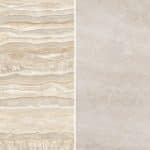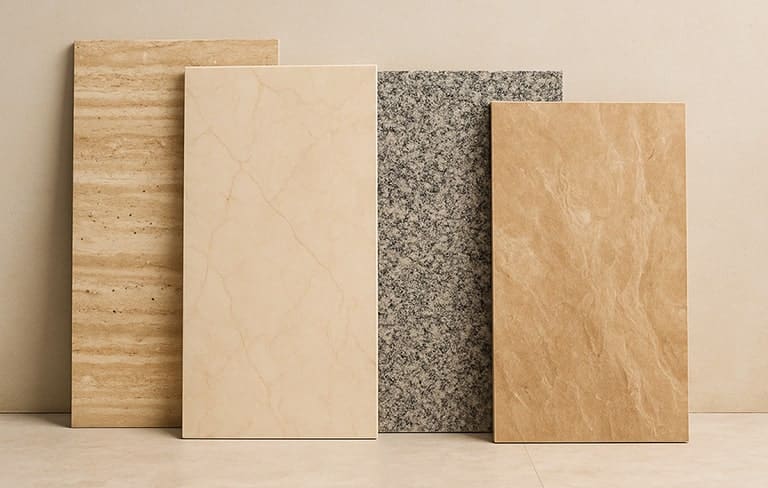
The best facade stone for northern Iran
2025-03-08
Veined or Non-Veined Stone?
2025-04-05What are the differences between travertine and marble?
Natural stones are recognized as one of the main pillars of the construction industry, but choosing between them can be challenging. Travertine and marble are two popular types of stone in the world, each with its own specific features and uses. If you are planning a construction project, choosing between these two types of stone may be difficult for you. In this article, we will examine the features, advantages, and disadvantages of each of these stones to help you make a better choice.
Features of Travertine
Structure and Chemical Composition
Travertine is a type of sedimentary rock that forms naturally near hot springs and in humid areas. This stone is primarily composed of calcium carbonate and, due to natural processes, has cavities and pores that add to its beauty and lightness. This porous structure helps travertine act as a thermal and sound insulator.
Appearance and Color Variations
Due to the presence of cavities and natural lines, travertine has a diverse appearance and is usually available in colors such as white, cream, brown, red, and yellow. This color variety allows designers to utilize it in interior decoration and the exterior facades of buildings. The surface texture of this stone can vary from smooth to rough, and this feature helps in its use in different designs.
Resistance and Durability in Various Conditions
Travertine shows good resistance to weather changes and temperature. Additionally, this stone has resistance to moisture due to its porous structure. However, it should be noted that it may be vulnerable to chemical and acidic substances. Overall, the durability of travertine is greater than that of other stones, making it a good choice for high-traffic areas.
Features of Marble
Structure and Chemical Composition
Marble is also a type of natural stone that is composed of calcium carbonate and may have different colors and patterns due to impurities. This stone has dense crystals and is thus recognized as both a suitable building material and for its beauty.
Appearance and Polished Surface
In terms of appearance, marble, with its shiny and polished surface, adds a luxurious and attractive appeal to any space. The various colors of this stone allow architects to use it in diverse projects. Moreover, cleaning marble is much easier due to its smooth surface.
Resistance and Durability Against Pressure and Scratches
Marble has good resistance to pressure, but there is a possibility of damage from deep scratches. To enhance the durability of this stone, special coatings can be used that help maintain its beauty. This stone, due to its beauty and strength, is an excellent choice for reception halls and luxurious places.
Applications of Travertine
Use in Interior Spaces
Due to its strength and beauty, travertine is widely used in interior spaces such as flooring and walls. This stone, with its diverse colors and textures, can give a unique appearance to a space. Especially in kitchens and bathrooms, its insulating properties can be beneficial.
Use in Exterior Spaces
Travertine also has good application in exterior spaces. With its resistance to UV and various weather conditions, this stone is an ideal option for the exterior facades of buildings. Additionally, it can be used in landscape design.
Advantages of Choosing Travertine for Construction Projects
Choosing travertine offers more advantages due to its lower cost, ease of installation, and recyclability. This stone can also be effective in reducing energy costs and is considered a good choice for the environment.
Applications of Marble
Use in Interior Decoration
Marble is considered one of the popular materials for interior decoration due to its charm and beauty. This stone can be used in walls, flooring, and even in furniture design. Additionally, due to its high resistance to scratches, it is a suitable option for high-traffic areas.
Special and Luxurious Projects
Marble is the best choice for luxurious and special projects. Architects often use this stone in the design of hotels and palatial villas. Furthermore, the ability to choose from different colors and patterns of marble allows designers to respond to customers’ preferences.
Advantages of Choosing Marble for Construction Projects
Despite the higher cost, marble brings beauty, durability, and easy cutting possibilities.This stone also has low-cost recyclability and maintenance, making it an ideal option.
Cost and Maintenance Comparison
Purchase and Installation Costs
When comparing the purchase costs of travertine with marble, it should be noted that travertine generally has a lower cost. Additionally, the installation costs of marble may be higher due to the need for more precision and skill.
Maintenance and Care of Stones
Marble requires more care, especially regarding stain resistance. Special coatings can help maintain its beauty. On the other hand, maintaining travertine is generally simpler.
Long-Term Cost Comparison
In terms of long-term costs, travertine is a better option due to lower purchase and maintenance costs, whereas marble can have a longer lifespan and increase property value if well maintained.
Tips for Choosing the Right Stone
Factors Influencing Stone Selection
When selecting the right stone, the type of application, cost, and personal preference are particularly important. Stones should be chosen according to needs and usage conditions. Additionally, knowing the physical and chemical properties of stones is also essential.
Key Purchase Tips from Mr. Silver Company
Mr. Silver Company provides useful tips to its customers when purchasing stone. Among these tips are checking quality certificates and the possibility of viewing previous samples. These factors can significantly assist in making a better choice.
Attention to Weather Conditions and Usage
The weather conditions of the area are among the important factors in choosing the type of stone. Particularly in humid areas, travertine is a more suitable option due to its high resistance. Moreover, the type of use of the stone also influences this selection.
Conclusion
Choosing the right stone between travertine and marble depends on the project needs, budget, and personal taste. Due to its unique features, travertine is an ideal choice for outdoor and high-traffic spaces. On the other hand, marble, with its beauty and color variety, is a suitable option for interior decoration and luxury projects. Considering the mentioned factors and consulting with experts, you can choose the best option for your projects and thus achieve the best results.




